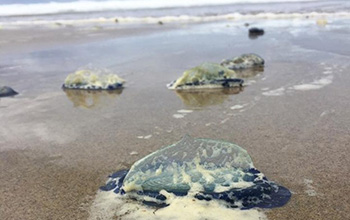Observations by citizen scientists help researchers find patterns in jellyfish strandings

Velella velella, also called "by-the-wind sailor" jellies, washed ashore at Moolack Beach, Oregon.
As their name suggests, by-the-wind sailor jellyfish know how to catch a breeze. Using a stiff, translucent sail propped an inch above the surface of the ocean, these teacup-sized organisms skim along the water, dangling a fringe of delicate purple tentacles just below the surface to capture zooplankton and larval fish as they travel.
At the mercy of the wind, these jellies, sometimes numbering in the trillions, can wash ashore on beaches around the world, including up and down the U.S. West Coast, in what is called a stranding event. While these mass stranding events are hard to miss, very little is known about how or why they happen.
Now, thanks to 20 years of observations from thousands of citizen scientists, University of Washington researchers funded by the U.S. National Science Foundation have discovered distinct patterns in the mass strandings of by-the-wind sailors, also called Velella velella. Large strandings happened simultaneously from the northwest tip of Washington south to the Mendocino coast in California in years when winters were warmer than usual. The results were published in the journal Marine Ecology Progress Series.
"Citizen scientists have collected the largest and longest dataset on mass strandings of this jelly in the world," said senior author Julia Parrish of the University of Washington and executive director of the Coastal Observation and Seabird Survey Team, known as COASST.
"This paper contributes to fundamental scientific knowledge of this organism in a way that traditional 'mainstream' marine science has been unable to do," said Parrish. "Thousands of trained, dedicated observers are better than any satellite because they know their beaches and can alert us if something is weird or unusual."
COASST's citizen scientists are trained to search for and identify carcasses of marine birds that have washed ashore at sites from northern California to the Arctic Circle. Participants are asked to record and submit photos of anything strange or different they see on their stretch of beach.
"Projects such as COASST are opportunities for people to become curious and explore their local environments, all while participating in scientific research," said Ellen McCallie, a program director in NSF's Division of Research on Learning in Formal and Informal Settings. "More citizen science opportunities can be found on such sites as citizenscience.gov. Whether you choose a project that gets you outside or is virtual, public participation in scientific research is powerful and fun."






